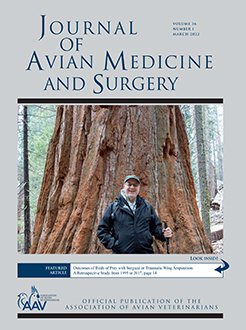The objectives of this retrospective study were 1) to characterize humeral fractures in raptors at a rehabilitation program, 2) to determine risk factors for closed and compound humeral fractures in the raptors, and 3) to investigate prognostic factors for humeral fractures in raptors. Of the 6017 birds of prey admitted over 15 years to the Université de Montréal raptor rehabilitation program, 461 birds presented with a humeral fracture. The highest occurrences of humeral fractures were documented in short-eared owls (33%; Asio flammeus), Northern hawk-owls (24%; Surnia ulula), long-eared owls (20%; Asio otus), and Northern harriers (19%; Circus hudsonius). Humeral fractures were more common in males, and species from the intermediate weight group (300 g to 1 kg) were more likely to have compound humeral fractures than birds from the lower and higher weight groups. Humeral fractures of the middle and distal third of the bone were diagnosed as compound more often than fractures of the proximal third. A correlation between the occurrences of humeral fractures and the relative average width of the humerus for each species was observed and suggests that species with slender humeri have an increased likelihood of compound humeral fractures. Following the triage criteria used at this rehabilitation program, surgical (119 birds) or nonsurgical (77 birds) treatments were attempted. Release rate for birds without concomitant conditions in which a treatment was attempted was 39.3% (59/150) and did not significantly differ between closed and compound fractures, which suggests that the triage criteria used for compound fractures in this program were adequate. Our findings emphasize that raptors should not be systematically euthanatized when presented with compound humeral fractures to a rehabilitation facility.
How to translate text using browser tools
2 May 2022
Risk Factors and Prognosis for Humeral Fractures in Birds of Prey: A Retrospective Study of 461 Cases from 2000 to 2015
Thomas Coutant,
Stéphane Lair,
Guy Fitzgerald,
Clément Perret-Thiry,
Claire Vergneau-Grosset
ACCESS THE FULL ARTICLE
Avian
birds of prey
humerus
osteosynthesis
outcome
surgery
wing fracture





